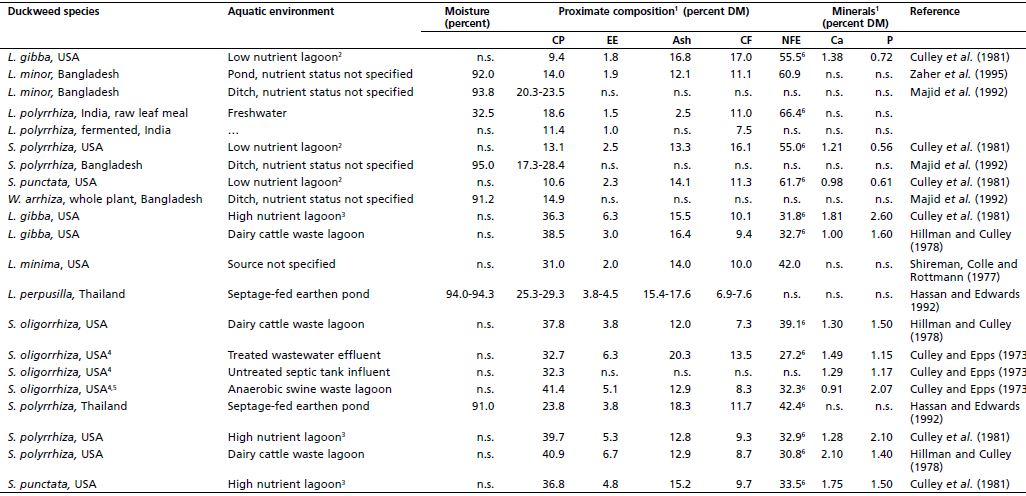3.4. Chemical composition
Each frond of duckweed absorbs nutrients through the whole plant, not through a central root system, directly assimilating organic molecules such as simple carbohydrates and various amino acids.
The entire body is composed of non-structural, metabolically active tissue; most photosynthesis is devoted to the production of protein and nucleic acids, making duckweeds very high in nutritional value. The nutritional content of duckweed is probably more dependent on the mineral concentrations of the growth medium than on the species or their geographic location. Water low in nutrients generally results in reduced nutritional content in duckweed. Crude fibre content is generally lower (varying between 7-10 percent) for duckweed grown in nutrient-rich water than that grown in nutrient-poor water (11-17 percent).
Compared with most plants, duckweed leaves have little fibre (5 percent in cultured plants) as they do not need to support upright structures (Leng, Stambolie and Bell, 1995). Crude fibre content was generally lower, varying between 7-10 percent, for duckweed grown in nutrient-rich water as opposed to 11-17 percent for duckweed grown in nutrient-poor water. In general, the ash content ranges between 12-18 percent (Leng, Stambolie and Bell, 1995).
Duckweeds are known to accumulate large amounts of minerals in their tissues. Skillicorn, Spira and Journey (1993) reported that fibre and ash contents are higher and protein content lower in duckweed colonies with slow growth. Duckweeds are rich source of nitrogen, phosphorous, potassium and calcium (Guha, 1997). The concentration of N and P in duckweed tissues depend on the amount of N and P in the water, up to a threshold concentration that has not been clearly defined. Above this threshold, there is little increase in the tissue. Culley et al. (1978) suggested that under lagoon conditions, 20-30 mg/l TKN might be required to maintain a crude protein level above 30 percent. The crude protein content of duckweeds grown on various nutrient solutions ranges from 7 to 45 percent of the plant dry weight, depending on the nitrogen availability (Culley et al., 1981). When conditions are good, duckweed contains considerable protein, fat, starch and minerals, which appear to be mobilized for biomass growth when nutrient concentrations fall below the critical levels for growth. Nutrient contents in duckweed may therefore vary according to the conditions in which it is grown. Slow growth, starvation and aging have been reported to result in protein levels as low as 7 percent DM (Landolt and Kandeler, 1987).
A summary of the nutritional composition of different species grown under different environmental conditions is presented in Table 3.12. Fresh duckweed contained about 91-95 percent water and the moisture content is apparently not influenced by the medium under which it was grown. Duckweed species grown under nutrient-poor water or under sub-optimum nutrient conditions have crude protein contents varying between 9-20 percent, while the level varied from 24-41 percent for duckweed species grown in nutrient-rich water. The crude protein content of duckweed seems to increase from trace ammonia concentrations to 7-12 mg N/L when crude protein reaches a maximum of about 40 percent (Leng, Stambolie and Bell, 1995). Similarly, the lipid content was lower (1.8-2.5 percent) in duckweed species grown in nutrient-poor water, while it generally varied between 3-7 percent for duckweed grown in nutrient-rich water. The medium in which duckweed was grown or the nutrient status of water did not influence the ash content of duckweed (Leng, Stambolie and Bell, 1995). Skillicorn, Spira and Journey (1993) reported that fibre and ash contents are higher and protein content lower in duckweed colonies with slow growth.
Studies by Porath, Hepher and Koton (1979) and Rusoff, Blakeney and Culley (1980) show clearly that the duckweed indeed has high quality protein. It has a better essential amino acid profile than most plant proteins and more closely resembles animal protein than any other plant proteins. According to Guha (1997), the protein of duckweeds is rich in certain amino acids that are often rather low in plant proteins. The nutritional value of Lemnaceae can be compared favourably with that of alfalfa in terms of lysine and arginine, two amino acids important in animal feeds. Duckweeds are rich in leucine, threonine, valine, isoleucine and phenylalanine and are low in methionine and tyrosine.1 Some information on the amino acid content of various aquatic macrophytes is contained in Annex 1. Annex 1 Table 3 shows mean values determined for amino acids in four species of duckweed. It is evident that the values for the essential amino acids compare favourably with the FAO reference pattern, with the exception of methionine. The levels of amino acids are very similar in the various species and all the essential amino acids were generally present.
Cultured duckweed has high concentrations of trace minerals and pigments, especially ?-carotene and xanthophyll (Haustein et al., 1988). Duckweeds store varying amounts of calcium as calcium oxalate crystals in the vacuoles. Calcium oxalate may be toxic in large doses and the amount should be reduced to make duckweeds more
1 www.mobot.org/jwcross/duckweed/nutritional-composition.htm
Table 3.12
Chemical analyses of various duckweed species grown under different environmental conditions

1 CP = crude protein; EE = ether extract; CF = crude fibre; NFE = nitrogen free extract; Ca = calcium; P = phosphorus
2 Low nutrient lagoon contained less than 5 mg/l TKN
3 High nutrient lagoon contained more than 30 mg/l TKN
4 Proximate composition and mineral content values corrected to dry basis
5 Mean of eight values sampled over five months period
6 Adjusted or calculated; not as cited in original publication
Floating aquatic macrophytes – Duckweeds 43
nutritious and digestible (Franceschi, 1989). The metabolic precursor of oxalate is L ascorbic acid (vitamin C). A study with water lettuce (Pistia stratiotes) (see section 5) indicates that L-ascorbate and oxalate are synthesized within the crystal idioblast cells (Kostman et al., 2001).